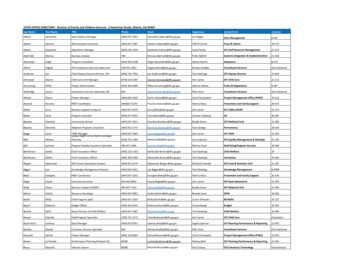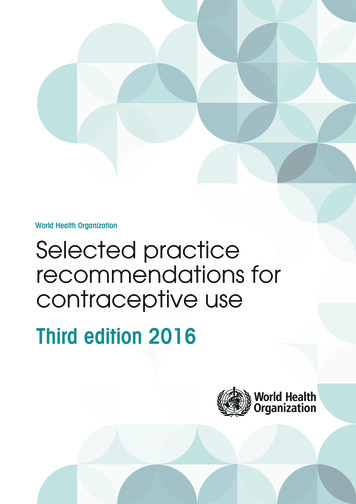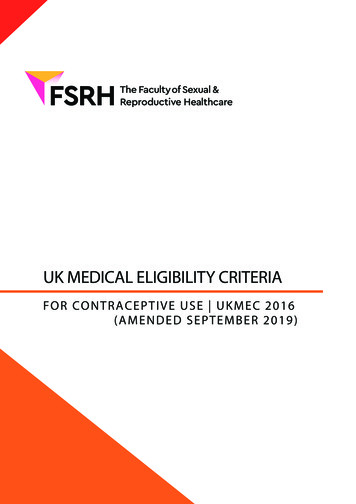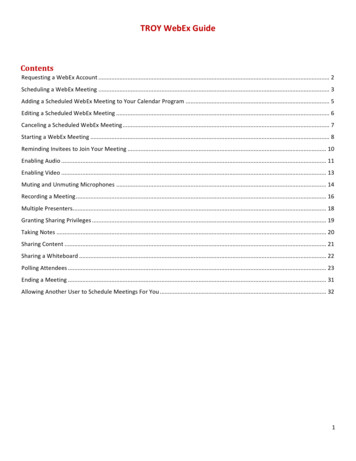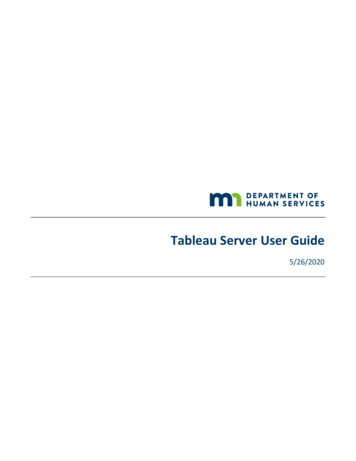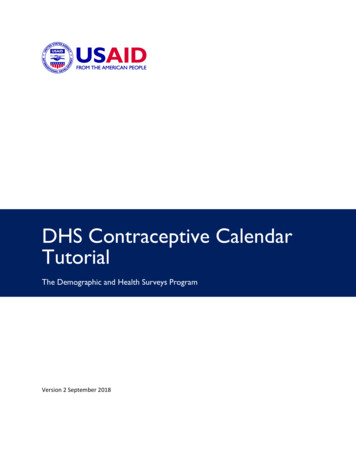
Transcription
DHS Contraceptive CalendarTutorialThe Demographic and Health Surveys ProgramVersion 2 September 2018
This publication was developed with support provided by the United States Agency for InternationalDevelopment (USAID) through The Demographic and Health Surveys Program (#AID-OAA-C-1300095).The views expressed are those of the authors and do not necessarily reflect the views of USAID orthe United States government.The DHS Program assists countries worldwide in the collection and use of data to monitor and evaluatepopulation, health, and nutrition programs. Information on The DHS Program may be obtained from ICFInternational, 530 Gaither Road, Suite 500, Rockville MD, 20850, USA; telephone: 301-407-6500; fax:301-407-6501; e-mail: info@DHSprogram.com; website: www.DHSprogram.com.
ContentsIntroduction . 4Module 1: What is the contraceptive (or reproductive) calendar? . 4Module 2: How are the calendar data stored in datasets and how do I analyze the calendar data? . 4Module 3: String parsing of the calendar . 4Module 4: Restructuring the calendar into a file of single months . 4Module 5: Introduction to event files and how to use them . 4Module 6: Contraceptive discontinuation, failure and switching rates . 4Programs and coding resources . 5Module 1: What is the contraceptive (or reproductive) calendar? . 61.1. What is the calendar? . 6Table 1. Standard codes used in calendar in DHS7 questionnaire . 7DHS-7 Contraceptive Calendar . 81.2. How is the calendar completed in interviews? . 91)Birth history. 92)Current pregnancy . 93)Terminated pregnancies . 94)Current contraceptive method . 105)Episodes of contraceptive use in the calendar period . 10Example of a completed calendar. 121.3. Uses of the calendar data . 131.4. A brief history of the calendar in DHS. 141.4.1History . 141.4.2Changes over time . 14Table 2. Calendar columns in standard questionnaires . 151.4.3Survey-specific modifications . 201.5. Limitations of the calendar data . 22Module 2: How are the calendar data stored in datasets and how do I analyze the calendar data? . 242.1. How are calendar data stored in datasets? . 24Table 3. Standard coding scheme used in recode files (R) and standard DHS-7 questionnaires (Q) . 25How can I understand the calendar? . 261
Supplementary variables used with the calendar . 282.2. Analyzing the calendar data in statistical software . 29Module 3: String parsing of the calendar . 303.1. String functions . 303.2. Example data. 32Example 1 – Basic string functions . 33Example 2 – Last pregnancy, duration of pregnancy and method used before pregnancy . 40Example 2A – Find the CMC of the last birth in the calendar . 42Example 2B – Find the duration of pregnancy for that birth . 51Example 2C – Check if a contraceptive method was used at some time before the pregnancy, withinthe calendar period, and find the method. 56Example 3 – Postpartum family planning . 68Example 4 – Stillbirths and perinatal mortality . 74Module 4: Restructuring the calendar into a file of single months . 85Example 5 – Reasons for discontinuation in the last five years by method . 86Example 6 – Contraceptive prevalence over time . 95Module 5: Introduction to event files and how to use them . 1045.1. Introduction to event files . 1045.2. How to create an events file . 108Example 7 – Create events file . 1085.3. Using events files in analysis . 122Example 8 – Reasons for discontinuation from an events file. 123Module 6: Contraceptive discontinuation and switching rates . 1276.1. Introduction to contraceptive discontinuation rates, failure rates and switching rates . 1276.2 How to calculate discontinuation rates . 131Example 9 – Twelve-month discontinuation, failure, and switching rates . 132Programs and coding resources . 151Examples . 151Survey-specific coding. 153Realignment of string variables . 153Data fixes. 154Calendar recoding . 1552
Annexes . 157Acknowledgements. 157References . 1583
IntroductionThe Demographic and Health Surveys (DHS) Contraceptive Calendar Tutorial is designed to help DHS datausers understand the DHS Contraceptive Calendar, its history, how it is completed in an interview, howthe data are stored in the Individual Recode (IR) datasets, uses of the calendar data, and how to analyzethe data.The DHS Contraceptive Calendar Tutorial is aimed at data analysts who are very familiar with statisticalsoftware and have prior experience working with DHS datasets, and who wish to learn to analyze the DHScalendar data. This tutorial does not provide an introduction to statistical software or the DHS datasets to learn about DHS datasets, please see the DHS Program tutorial video series.The tutorial is presented in six modules:Module 1: What is the contraceptive (or reproductive) calendar?Module 1 describes the DHS Contraceptive Calendar. The module provides some background and historyfor the DHS Contraceptive Calendar, and describes the structure of the calendar in the questionnaire andhow the data are collected.Module 2: How are the calendar data stored in datasets and how do I analyze the calendardata?Module 2 discusses how the data are stored in the recode file, the string variables used to hold thecalendar data, the coding scheme used for the calendar variables in the recode files, and how to “read”the calendar data, and introduces the three main approaches used to process the calendar data - stringparsing, single month files, and event files.Module 3: String parsing of the calendarModule 3 describes the first approach to extracting data from the calendar, and provides four examplesof the use of string parsing.Module 4: Restructuring the calendar into a file of single monthsModule 4 discusses the second approach - converting the calendar strings into a file of single months and provides two examples of using this approach in analyzing the calendar data.Module 5: Introduction to event files and how to use themModule 5 introduces the third approach – creating event files – and provides an example program forproducing an event file from a DHS Individual Recode (IR) file. It then provides an example of using theevent file to analyze the reasons for discontinuation of contraception.Module 6: Contraceptive discontinuation, failure and switching ratesModule 6 tackles a subject of interest to many DHS data users - contraceptive discontinuation, failure andswitching rates. It provides a description of the multiple decrement life table approach used in DHS4
reports, and briefly discusses single decrement life tables. It then provides an example of thecontraceptive discontinuation rates using the event file.Programs and coding resourcesThe tutorial is accompanied by a set of programs written in Stata and in SPSS to support the examples.Additionally, two videos are also available to facilitate understanding the calendar data:1. DHS Contraceptive Calendar Tutorial Part 1: Completing the Contraceptive Calendar2. DHS Contraceptive Calendar Tutorial Part 2: Data Structure of the Contraceptive CalendarAll materials can be found at the DHS Contraceptive Calendar Tutorial website atdhsprogram.com/data/calendar-tutorial.Additional information can be found in the online Guide to DHS Statistics or the PDF version.The Guide to DHS Statistics defines and explains how statistics in DHS final reports arecalculated and includes several topics that use calendar data.5
Module 1: What is the contraceptive (or reproductive) calendar?Goal of the module: For analysts to understand what the DHS calendar is, its history, and how the dataare collected.1.1. What is the calendar?The DHS calendar is a month by month history of certain key events in the life of the respondent for thecalendar period preceding the date of interview. It is sometimes known as the reproductive calendar orthe contraceptive calendar as the main information collected in the calendar relate to reproduction andcontraception. The calendar is “recent” in that only events occurring in the year of the survey plus thefive1 full calendar years preceding the current year are included.In the survey, each column of the calendar typically includes 72 boxes2(each representing one month of time) divided into six sections (eachrepresenting one year or 12 months of time) in which to record informationabout the woman’s experiences with childbearing and contraceptive use.The calendar is divided into separate columns for different types ofactivities or event. In the current standard DHS-7 questionnaire thecalendar consists of two columns:1) Births, pregnancies, terminations and contraceptive use2) Reasons for discontinuation of contraceptive useThe calendar collects a complete history of women’s reproduction and contraceptive use for a period ofbetween 5 and 7 years prior to the survey. The exact length of the period covered by the contraceptivecalendar varies depending on the duration of data collection, whether the survey overlapped two yearsand the month in which the respondent was interviewed. In most surveys the period covered by thecalendar (referred to as the “calendar period”) includes the months up to the month of interview in theyear of interview, plus the five1 calendar years preceding the year of interview. For example, if theinterview took place in April 2015, the calendar period would cover April 2015 back to January 2010, atotal of 64 months. In surveys that overlap two calendar years, where an interview is carried out in thesecond of those years, the period can include six calendar years prior to the year of interview. We willrefer to the calendar period throughout this tutorial, meaning the period for which data were collectedfor a respondent. The calendar period will vary from respondent to respondent depending on the date ofinterview.12Six years for surveys overlapping two years.In surveys overlapping two years, an additional 12 boxes for the additional year may be included in the calendar.6
For each month in the calendar period a single letter or digit code is used to record information concerningthe events and activities. For example, any of the following events during the calendar period would bedocumented:- For each birth a letter “B” (Birth) is recorded in column 1 for the month of birth.- For each preceding month of pregnancy a letter “P” (Pregnancy) is recorded in column 1.- If the respondent had a miscarriage, abortion, or stillbirth, a letter “T” (Termination) is recordedin column 1 for the month the pregnancy ended, and a letter “P” (Pregnancy) is recorded for eachpreceding month of pregnancy.- If the respondent used contraception in the intervening months between pregnancies, then eachmonth of use of a contraceptive method is recorded in column 1 using the code for that method.Below are the codes used in the DHS-7 questionnaire for column 1 (Births, pregnancies and contraceptiveuse) and column 2 (Reasons for discontinuation of contraceptive use):Table 1. Standard codes used in calendar in DHS7 questionnaireCodeBPT0123456789JKLMXYColumn 1Births, pregnancies or contraceptive useBirthsPregnanciesTerminationsNo methodFemale sterilizationMale e condomDiaphragmFoam or jellyLactational amenorrhea methodRhythm methodWithdrawalOther modern methodOther traditional methodCode012345678FADXZ7Column 2Reason for discontinuationInfrequent sex/husband awayBecame pregnant while usingWanted to become pregnantHusband/partner disapprovedWanted more effective methodSide effects/health concernsLack of access/too farCosts too muchInconvenient to useUp to God/fatalisticDifficult to get pregnant/menopausalMarital dissolution/separationOtherDon't know
DHS-7 Contraceptive Calendar8
1.2. How is the calendar completed in interviews?The calendar data are collected in a series of steps throughout the interview:1) Birth historyAfter the birth history section has been completed in the women’s interview, the interviewer checks thenumber of births in the calendar period. For each birth within the calendar period the interviewer placesa “B” in the first column in the row of the calendar corresponding to the month of birth and writes thechild’s name to the left of the “B” code. Then the interviewer asks the respondent how many months shehad been pregnant when she gave birth and records a “P” in each of the preceding months according tothe duration of the pregnancy. The number of “P”s must be one less than the number of months that thepregnancy lasted as the “B” is considered to include the last month of pregnancy. This step is repeatedfor each birth within the calendar period. If there are twins, the birth is recorded only once in the calendarbut the names of both children are recorded to the left of the month of birth.Example: The respondent gave birth to one child in thecalendar period, in November 2014. The interviewerwould record a “B” in the calendar in row correspondingto November 2014. The interviewer would then ask thenumber of months the pregnancy lasted. If therespondent reports that she was nine months pregnantwhen she gave birth, the interviewer would record “P”s ineach of the preceding 8 months, i.e., in the monthsFebruary through October 2014, for a total of 9 months (a“B” and eight “P”s).2) Current pregnancyIf the interviewer ascertains that the respondent iscurrently pregnant and has asked the duration ofpregnancy, after recording the information in the body ofthe questionnaire, the interviewer also records thepregnancy in the calendar. The interviewer records a “P”in column 1 of the calendar in the month of interview andin each preceding month for the duration of thepregnancy. The duration of pregnancy is recorded incompleted months, so if a respondent was in her fifthmonth of pregnancy, this would be four completedmonths and four “P”s would be recorded in the calendar.3) Terminated pregnanciesThe interviewer records any terminated pregnancies (includes miscarriages, stillbirths, and abortions) inthe calendar period. For each pregnancy termination the interviewer records a ‘T’ for the pregnancytermination and a “P” for each preceding month of the pregnancy for the duration of the pregnancy. Asfor births, the number of “P”s is one less than the duration of the pregnancy.9
Example: A respondent had a miscarriage in November2011 and was in her fourth month of pregnancy, then shehad completed only three months of pregnancy a “T”would be recorded in column 1 of the calendar inNovember 2010 and two “P”s in September and October2010.4) Current contraceptive methodAfter recording all births and other pregnancies, the interviewer asks about contraception. If therespondent is currently using a contraceptive method, the interviewer asks for the month and year therespondent started using the method – that is the start of continuous use of the method, not the firsttime they used the method. The interviewer fills in the code for the contraceptive method currently usedin column 1 in the row corresponding to the month of interview and in the month started using themethod using the codes shown to the left of the calendar. If the respondent started using the methodprior to the start of the calendar the interviewer records the code in the first row of the calendar. Theinterviewer then connects the first and last month of contraceptive use with a line showing continuoususe of the method between these two dates (in the dataset the code for the method is repeated for eachmonth of use).5) Episodes of contraceptive use in the calendar periodThe respondent asks about other episodes of contraceptive use in the calendar period. For each openepisode (consecutive blank boxes in the calendar), the interviewer asks a series of questions to therespondent to ascertain the date and duration of use of contraception, if any, during that episode. In asurvey using a paper questionnaire this part of the interview is less structured and the questions beloware illustrative questions. In a survey using computer-assisted personal interviewing (CAPI) the interviewis more structured and uses the following questions: When was the last time you used a method? Which method was that?Between the (EVENT1) in (MONTH AND YEAR) and the (EVENT2) in (MONTH AND YEAR) did youuse a method of contraception?[EVENT1 may be the birth of a child, the termination of a non-live pregnancy, the end of a priorepisode of contraceptive use, and EVENT2 may be the start of a pregnancy or the beginning of alater episode of contraceptive use.]When did you start using that method?How long after (EVENT1) did you start using that method?How long did you use the method then?What happened when you stopped using that method: did you not use any method, did you startusing a different method, or did you become pregnant?For the end of each episode of contraceptive use recorded in column 1 of the calendar, the interviewerasks additional questions to ascertain the reason for discontinuing use of the contraceptive method andrecords the code for the reason for discontinuation in column 2 of the calendar in the row correspondingto the month of ending use of the method, such as:10
Why did you stop using the (METHOD)?Followed by probing questions, including: IF A PREGNANCY FOLLOWED: Did you become pregnant while using (METHOD), did you stop toget pregnant, or did you stop for some other reason?The possible response codes are those listed in table 1. Only the main reason for discontinuation isrecorded in column 2 in the row corresponding to the month the respondent stopped using the contraceptive method.While filling in the episodes of contraceptive use in between each birth or pregnancy, any periods in whichthe respondent was neither pregnant nor using a contraceptive method are filled with code “0” meaningthat no method was used in that month.After completing the data collection for the calendar, column 1 of the calendar will have a single coderecorded in every row, except for those rows after the month of interview. Column 2 will have a singlecode in the same month as the month of discontinuation of each episode of contraceptive use. Othermonths in column 2 are left blank.For many respondents completing the calendar is quite straightforward. For example, a woman who hasnever been sexually active, a woman who used no contraception and had no pregnancies in the calendarperiod, or a woman who used the same contraceptive method throughout the calendar period (e.g.sterilization, IUD or Implant) would have the same code in all months of column 1 and no codes in column2 of the calendar.11
Example of a completed calendarHere is an example of a completed calendar. Briefly looking at thecalendar, it is possible to read the reproductive and contraceptiveevents of this respondent.FIRST GLANCEThe example on the right shows a completed calendar of arespondent. At a first glance it is possible to know severalpieces of information: The respondent was interviewed in September 2015. The calendar spans 5 years and 9 months. There was a birth recorded (see the name written onthe calendar) There were methods of contraception that werediscontinued (note the codes present in Column 2)REPRODUCTIVE AND CONTRACEPTIVE EVENTSWalking through the series of steps the interviewer goesthrough and using Table 1 to interpret the codes, it ispossible to see there are five categories of information wecan read from this calendar:1) Birth historyBirth in 2014 after 9 complete months of pregnancy.2) Current pregnancyThe respondent is not currently pregnant.3) Terminated pregnanciesOne terminated pregnancy in November 2010 afterthree completed months of pregnancy.4) Current contraceptive methodThe current method being used is the pill.5) Episodes of contraceptive useFrom 2010 to 2014, the respondent had severalepisodes of contraceptive use including usinginjectables, the pill, and the rhythm method (periodicabstinence). Her reasons for discontinuing thesemethods included side effects or health concerns andbecoming pregnant while using.For more details on completing the calendar, watch the DHS Program tutorial video on completing thecalendar or see the DHS Interviewer’s manual.12
1.3. Uses of the calendar dataThe calendar provides information not collected in other parts of the DHS questionnaires. In particularthe calendar is used to collect information on births and pregnancies, including pregnancy terminations(or non-live births) – miscarriages, abortions, and stillbirths. While the data on live births are also collectedin the birth history3 (and are more readily analyzed using the birth history), the data on all non-livepregnancies in the calendar period are only collected in the calendar4. These data can be used to calculatepregnancy termination rates, including stillbirth rates, and, in conjunction with early neonatal mortalitydata, perinatal mortality rates.Additionally, the calendar collects information on all episodes of contraceptive use and the reasons fordiscontinuation of each method used. The data can be used to understand contraceptive use dynamics,and particularly contraceptive discontinuation rates, failure rates and switching rates using lifetableanalyses. Further, calendar data can be used to examine whether a contraceptive method was used beforea birth or pregnancy, or if and when a woman started using a method in the postpartum period.Below are a few examples of analyses that can be conducted with calendar data. Several of these are usedas examples later in the tutorial:AnalysisMethod used prior to the most recent birthPostpartum Family Planning: prevalence and methodStillbirths and perinatal mortalityReason for discontinuation of contraceptive methodContraceptive prevalence rate overtime, or at a specified timeContraceptive use of any method in the prior n monthsMethod switching in the prior n monthsNumber of methods used in the five years preceding the interviewAverage duration of contraceptive useAverage time to pregnancy after stopping use of a methodAverage time postpartum to starting use of contraceptionContraceptive discontinuation, switching and failure ratesImpact of contraceptive failure on unintended pregnancies3Tutorial examplesExample 2Example 3Example 4Example 5 Example 8Example 6The DHS data editing procedures attempt to ensure consistency of the information between the birth history and the calendar.Except in surveys that use a full pregnancy history, rather than a birth history, in which case all non-live births are captured inthe pregnancy history too.413
1.4. A brief history of the calendar in DHS1.4.1HistoryThe calendar was first developed for the DHS Program in the experimental surveys conducted in Peru andDominican Republic in 1986. In particular, these surveys looked at “the potential of a six-year calendar forthe collection of monthly data on contraceptive practice, breastfeeding, amenorrhea, postpartumabstinence and exposure to risk; the comparative merits of a calendar approach vs. the standard formatof collecting such information within each birth interval for estimates of fecundability, natural fertility,and contraceptive efficacy;” (Peru Experimental Survey 19865).Analysis of the data collected in the Peru survey showed improved information from the calendar formatin the experimental questionnaire to the previously used tabular format. Goldman, Moreno and Westoff(1989) noted that “several different comparisons indicate that reporting of information on contraceptivehistories in the experimental questionnaire is superior to that in the standard one.”Moreno, Goldman and Babakol (1991) found other major advantages to using the calendar: “it obtainsmore complete reports of use for periods prior to the survey; it allows for a detailed study of contraceptiveuse patterns; and it obtains information which is more internally consistent with other types ofinformation.”On the basis of these experimental surveys and the analyses that followed, the use of the calendar becamea standard part of the DHS Model A questionnaire for use in high contraceptive prevalence countries inthe second phase of DHS (DHSII), starting in 1990.1.4.2Changes over timeImplementation of the DHS calendar has varied over survey phases. In phasesII-IV, the calendar was included only in high contraceptive prevalencecountries, which used the DHS Model A questionnaire. In these phases, thecalendar included columns that collected reasons for discontinuation, as we
The tutorial is accompanied by a set of programs written in Stata and in SPSS to support the examples. Additionally, two videos are also available to facilitate understanding the calendar data: 1. DHS Contraceptive Calendar Tutorial Part 1: Completing the Contraceptive Calendar 2.
